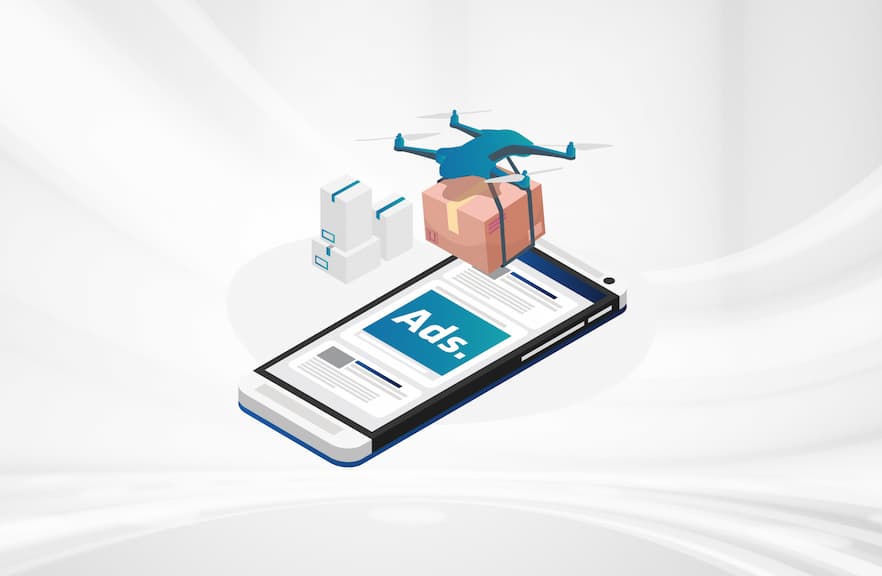Why tech-enabled properties evolve into media advertising properties more often than not and how q-commerce companies can take advantage of this to maximize profitability.
As early as 1989, when grocery delivery service Peapod came on the scene, quick commerce (q-commerce) companies made shopping more convenient by outsourcing tasks like grocery shopping. By design, the concept aligns perfectly with customer expectations like ease, convenience, and efficiency. But in practice, early q-commerce companies struggled to scale largely due to the costs of delivery in an already low margin—and low gross merchandise value (GMV)—business. And for many, grocery shopping is viewed as an experience rather than a chore (who doesn’t like the free samples at Costco?), slowing online grocery adoption even more.
As a result, online grocery platforms have struggled on both the supply and demand side. As of 2018, online purchases totaled less than 3% of overall grocery sales. COVID-19 overhauled how consumers purchase groceries, forced households into self-isolation, and, in turn, created incentives both for the demand side and the supply side. Online grocery share rose to 25% in 2020-21—rapidly outpacing its predicted growth. This gave rise to a plethora of global q-commerce startups like Instacart, GoPuff, Getir, Gorilla, Dunzo, and Swiggy Instamart. However, post-pandemic, the industry has reached an inflection point
The industry is at a crossroads
While COVID-19 undoubtedly boosted the online grocery category by creating the right incentives on both the supply and demand side, q-commerce companies are still struggling to prove to investors that they have a sustainable business model. Looking at other D2C players in CPG and retail, it is easy to see that the economics of last-mile delivery can be disheartening.
Grocery items are already low margin and with inflation, pricing strategies are more important than ever. With previous models, on-demand delivery on a long-term basis was not sustainable for either consumers or retailers. The early stage of this mad dash for market share was a land-grab game for sellers—every player focused on acquiring as many customers as possible without regard for profitability. The cost of customer acquisition was high and no real solutions had been proposed to bring efficiency to the last mile delivery. To boot, the momentum they had built came to a grinding halt as venture funding dwindled at the end of 2021. Additionally, as COVID waned, more consumers resumed in-store shopping.
Charting a path to profitability
Q-commerce companies with a desire to survive, scale and approach profitability can consider several different approaches to building a more viable business model.
- The Moonshot – Last-mile delivery becomes much more capital efficient with the automation of in-store operations. Using a combination of drones, robots and AVs to operate dark stores in urban areas and facilitate delivery, you can eliminate staffing in this area and keep costs at a minimum. Startups like Starship delivery robots are experimenting with pieces of this puzzle in limited-variable scenarios like college campuses, and while this is nice to think about, it is, realistically, still years away. Even more, the concept is years away from a social perspective. The buzz about no-touch, technology-powered delivery, which gained popularity during the pandemic, has waned as consumers crave the return of in-person experiences. Bigger retail players like Amazon and Uber are too far ahead for Instacart, GoPuff and Drizly to compete.
- Backward Integration – Why be just a delivery service if you can be the grocer and the brand owner as well? Expanding on the inherent advantage of q-commerce: ownership of the customer’s path to purchase, backward integration is a viable opportunity for on-demand delivery to become profitable.
By way of customer data, q-commerce companies own the customer, their experience, how they discover products and the payment. To backward integrate (like GoPuff did when it acquired BevMo), means owning more of the value chain, eliminating the need to split margins with the retailer, using lower-cost dark stores, and getting into private labels. The backward integration model brings needed efficiency to this process, but it is very capital-intensive and not as resilient to changes in demand. Leaders exploring backward integration should have a contingency plan for when demand declines to prevent being saddled with all of the capital expenditures.
- Make your app an ad platform – Last, but most importantly in terms of viable short-term solutions that can be more quickly implemented is for q-commerce companies to think and act like an ad platform. Any tech-enabled app or platform that reaches a critical mass of engaged users eventually reaches a point where the key to scaling past subscription fees becomes about ways to generate ad revenue. This is something every social media platform has gone through. The formula for media advertising success is simple. The more people who see your content and interact with it, the greater the potential for increasing ad revenue.
One of the first questions I was asking in mid-late 2020 was: “What will the pandemic do to trade promotions?” Meaning, how will CPG brands promote their products on Instacart? At the height of the pandemic, there were no promotions. None were needed because everything was flying off the shelves and retailers were working overtime just to have things in stock.
The first of such digital ads started appearing in 2021. They mimicked the kind of in-store coupon customers were used to. “Buy $30 of qualifying products and get $5 off” were commonplace. They were run by retail supernovas like P&G that own multiple brands. This move makes sense for both the brand and the platform because the promotion dollars already existed within the marketing budget and simply needed to be reallocated. This has now evolved to include content marketing strategies with Instacart curating recipes and cooking tutorials (that also feature the required ingredients that viewers can add to their cart). Instacart’s acquisition of data and analytics partner, Eversight, points to a shift in the market where q-commerce players are beginning to see the dividends of bringing data science to digital promotions.Furthermore, maintaining a smaller digital shelf increases competition and puts control of the consumer experience into the hands of the platform operators who can sell those ads at a premium while also offering brands an opportunity to experiment and personalize. In the short term, using the power of the platform supported by advertising, q-commerce can drive revenue by transforming how customers learn about and choose products. We are already seeing platforms like Drizly expand their advertising opportunities in order to help brands get closer to their customers.
What to watch for
Q-commerce platforms have a small window of opportunity to capitalize on the ad platform mindset and strategy before it becomes commonplace for brands. Ads, promotions and content will need to be increasingly personalized to each individual customer based on shopping behaviors and preferences. This results in better offers and better pricing for each consumer individually. Success will require the use of data and analytics to understand exactly what consumers buy from where, and when and exactly what they search and choose from the given options. From Netflix to TikTok, recommendation engines are built on advanced AI/ML models.
Q-commerce entities are not the only ones to benefit from this emerging access to first party data. CPG brands who historically rely heavily on “trade promotion effectiveness” analyses that fail to show the whole picture, can benefit by partnering with Instacart and the like to make the most of their promotion dollars. Q-commerce platforms may even offer more control of customer data to CPG companies that operate under a private label. Both sides of the marketplace stand to benefit with more data on the table.
As with all ad platforms dealing with personalization, q-commerce brands should be mindful of concerns around data privacy. As more data becomes available about consumer habits on yet another platform, it opens the door for potential abuse. To the consumer’s benefit, more data and better last-mile delivery means more options and a better experience, but brands can and have made missteps in the past with customer data
Q Commerce’s Future Outlook
Tentative plans are laid for development in q-commerce technology in the short, medium and long term. But until the technology infrastructure can support how customers want to shop, q-commerce platforms have an opportunity to survive and scale by adopting the mindset of an ad platform through targeted advertising and content marketing. While some key players have shined post-covid, the market is still primed for disruption—waiting for the right q-commerce platform to own their first party data and create an ad platform that is hyper-tailored to offer the customer exactly what they need, exactly when they need it.



